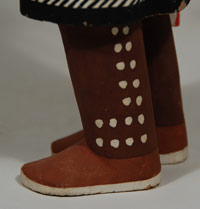Hopi Wakas'la'laiya (Cow Herder) Katsina Doll signed Hoyesva [SOLD]
+ Add to my watchlist Forward to Friend
- Category: Traditional
- Origin: Hopi Pueblo, Hopituh Shi-nu-mu
- Medium: cottonwood, ribbon, feathers
- Size: 12-1/4” tall
- Item # C3360T SOLD
Peter Shelton, Jr. is widely recognized as one of the major carvers of Katsina dolls in the mid-20th century. He and his brother, Henry Shelton, are names recognized by collectors of older carvings. He contributed to a style of more detail such as folds in kilts and shirts. This katsina doll appears to be of the style of his work in the 1950s and 1960s.
When we first received this carving, there was a question in my mind whether it was the First Mesa Shalako Katsina who wears a velvet ribbon shirt or the Navan Katsina who also wears a velvet ribbon shirt. Neither seemed quite correct but both seemed to be possibilities. As I always do when I am unsure about a katsina, I consulted with the expert on Hopi and Zuni Katsinas—Chad Burkhardt. I have known Chad since he was about 10 years old and he would come to the Albuquerque gallery and stand in front of the 10-foot showcase full of Katsina dolls and proceed to name each of them. It was remarkable that a person of that age was so knowledgeable and interested in such an esoteric subject. He said this one is the Wakas'la'laiya (Cow Herder) Katsina.
The Wakas'la'laiya Katsina is the side dancer for Wakas'katsinam (Cow Katsinas) when they come as a group. He has a small round rattle of the type that this doll is holding and is dressed just like this doll. The Wakas'katsinam represent animal spirit messengers to the Rain gods. Their songs and dance movements are prayers for rain, and are symbolic of animals' self-sacrifice in supplying food to sustain life." (Secakuku)

This carving was very well made. The katsina doll stands erect, with one foot slightly in front of the other, as if in the process of taking a step. It stands alone without support or may be hung from the string around its neck.
The shirt and kilt were carved to show folds, and the ribbons over the shoulder are real, not painted. The painting of the embroidered sash is excellent. The carving is signed Hoyesva under one foot.
Condition: He is in very good condition, with no evidence of damage.
Provenance: from the Michael Frost estate
Recommended Reading: Hopi Katsina: 1,600 Artist Biographies by Gregory Schaaf
- Category: Traditional
- Origin: Hopi Pueblo, Hopituh Shi-nu-mu
- Medium: cottonwood, ribbon, feathers
- Size: 12-1/4” tall
- Item # C3360T SOLD



